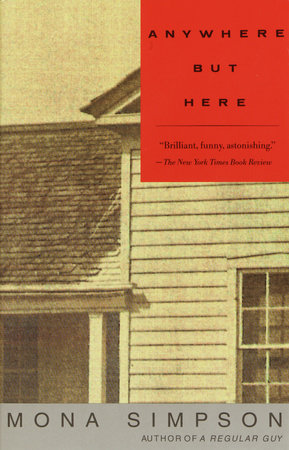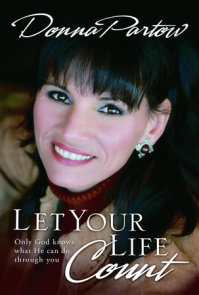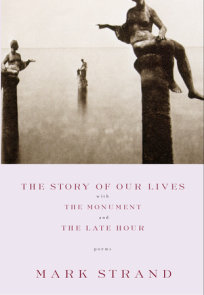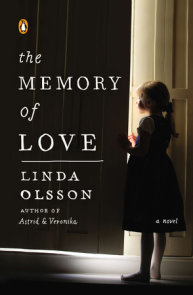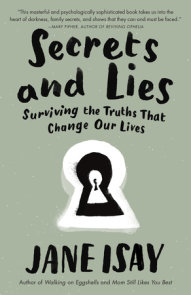READERS GUIDE
The questions, discussion topics, and author biography that follow are designed to enhance your group’s reading of Mona Simpson’s novel Anywhere But Here. We hope that they will provide you with new ways of looking at a novel produced by an American realist hailed by critics as one of her generation’s finest writers. With this work, Mona Simpson shows herself to be a sensitive and incisive analyst of the broken family, with an uncommon insight into the child who is at the mercy of parents who are absent, restless, narcissistic, dishonest or emotionally unstable. While it engages serious contemporary social issues, this work also makes for compulsive and deeply enjoyable reading, with characters who absorb our attention and involve us completely in their world.Introduction
Mona Simpson’s ambitious first novel Anywhere But Here became a national bestseller upon its publication in 1987. It traces the difficult childhood and coming-of-age of Ann August, the daughter of a woman whose quest for the American dream moves the two of them from Wisconsin to California and from one odd situation to another, with Ann at the mercy of her mother’s strange whims. Ann has inherited the rich black hair of her Egyptian father, who left when she was little. Her mother, Adele, insists it is her hair that makes her special–"cuter than Buffy" on A Family Affair–and that might make her a successful child television star. One day Adele decides to leave her second husband, Ted, and taking his Lincoln Continental and his gasoline credit card, she sets off with ten-year-old Ann for Los Angeles.Ann is an unusually attentive and observant child who reflects ruefully on the life she leads with her mother. Left behind in Wisconsin are the two people Ann loves best in the world: her grandmother Lillian and her cousin Benny. Adele is at the center of Ann’s troubles: always hoping to get rich, to get married again, to have a more comfortable life, she takes an apartment in Beverly Hills that she cannot afford to furnish. Here they try to appear normal among the rich and fashionable while Adele dates wealthy men, spends too much on clothes, fails to pay the bills, and bounces checks. Lending depth and context to the story of Adele and Ann are narratives by Adele’s mother, Lillian, and her sister Carol.
Adele and Ann are unique and powerful characters, fully created, who linger long in the reader’s mind. Mona Simpson says about Anywhere But Here, "The book is about roots and the people who went west and tried to get more from life, because that seems to me the story of life in America…. Adele is unstable, but troubled by American troubles: by the striving for gentility, the striving for a higher station. I wanted her dreams to be what got her into trouble." (Contemporary Literary Criticism, vol. 44, p. 97.)
Questions and Topics for Discussion
1. The opening of Anywhere But Here shows Ann and her mother in a wrenching scene of abandonment and reconciliation. How does this episode reverberate throughout the novel? What happens when Ann decides she doesn’t want her mother to come back for her?
2. The novel centers upon a mother-daughter relationship that is often painful, sometimes even violent, yet often loving as well. What is at stake in Ann’s fights with her mother? How are love and hatred bound together here? What is distorted about the roles of mother and daughter? Later in the novel Adele begins to threaten suicide; what part does this behavior play in the ongoing struggle between Ann and Adele?
3. Anywhere But Here explores the role of family roots, rootedness, and uprooting in contemporary American life. Is there a qualitative difference between the lives of Ann and Adele, who left home, and the lives of those they left behind? Are those who leave necessarily the more ambitious and adventurous ones? Do you see the passivity that seems to be characteristic of both Lillian and Carol as a reflection of or as a reason for their rootedness?
4. Who is the ideal parent in the novel and why? Is Adele the sort of person who should not have become a parent? Is there anything positive about Adele as a mother? What role do fathers play in the novel?
5. Why does Simpson avoid giving Adele a speaking part until the end of the book? What is the effect of the first-person narratives of Lillian and Carol? Do you think these provide a useful perspective on Ann’s story, or that the narrative might have been better spoken entirely by Ann?
6. Mona Simpson has said that in the beginning of her work on this novel she disliked Adele, but developed a kind of affection for her as the work went forward. How do you feel about Adele? What might be at the root of her spectacularly poor judgment? What are we able to learn about her own emotional history, her own childhood?
7. How does the novel portray sex for women and girls? What role does sexuality play in the lives of each of the four main female characters–Lillian, Adele, Carol and Ann? Why do you think Ann wants to take nude photographs of other children? Does Ann’s upbringing affect her ability to love?
8. Adele spends large amounts of money on expensive clothes that she can’t afford in the belief that her physical attractiveness is necessary for getting Ann "a new daddy." What is the place of material objects like clothes and cars in Adele’s sense of who she is? Is this a trait she passes on to Ann?
9. Apart from her grandmother, Ann’s closest and most secure relationship is with her cousin Benny. How does Ben’s death impact upon Ann’s life? What do you find strange about the description of the family’s gathering for the funeral visit?
10. How does food–especially ice cream–figure in the relationship between mother and daughter? Consider the place of food in Ann’s visit to her mother near the end of the book: why does Adele have so much food in the house? Why does Simpson include the detail of the ants on the carrot cake?
11. As noted earlier, Simpson has decided to save Adele’s narrative for the end of the novel. We have previously seen her through the eyes of her daughter, her sister, and her mother. Does this final section change your perspective on her in any way? Adele tells us that she has learned to feel better about herself through "The Course of Miracles," a popular self-help program (533). What does this section suggest about Simpson’s view of the current state of spirituality and moral self-examination in our culture?
12. Is there such a thing as "home" in Anywhere But Here? What would you say is the difference, symbolically, between Wisconsin and California in the novel? Is life shaped by place and social context as much as by one’s parents and upbringing? What is most unmistakably American about the novel?
For discussion of ANYWHERE BUT HERE, THE LOST FATHER, and A REGULAR GUY:
1. What are some of the ways in which these novels identify the problems of family life in contemporary American culture? What is Mona Simpson’s ideal of the family, and how do the families in these three novels fail or succeed in providing love, protection, identity, self-respect? Why is the importance of the child’s point of view central to all three novels?
2. In The Lost Father, Mayan says, "So much of what determined what was life and what dream was still only money" [p. 116]. In each of these works, one’s economic condition has a strong shaping influence on one’s life. Is money–or its lack–the most fateful element in life? Which characters in these works are most dependent on money, or on the idea of wealth, in imagining and creating the kind of life they desire?
3. There is a range of narrative techniques in these three novels. There are several first-person narrators in Anywhere But Here, a single first-person narrator in The Lost Father, and a third person omniscient narrator in A Regular Guy. How do these technical choices on Simpson’s part affect your experience of each of the novels?
4. About her approach to structure, Simpson has said, "I work paragraph to paragraph or even line to line…. I have an emotional sense of where things are going to, but I don’t do a whole chart or anything like that." (From interview with Susannah Hunnewell, The New York Times Book Review, 9 February 1992, p. 10.) How would you describe and differentiate the structure of these novels? Henry James fondly called the novel form "a loose baggy monster." Do you think that Simpson’s novels particularly fit this description?
5. How does Simpson control and convey the sense of time and of past and present? How important a role does memory play in these works?
6. Simpson started out as a poet, and her writing is often powerfully lyrical and imagistic. For example, in The Lost Father Mayan says of her mother, "in her private soul she is a child holding an empty glass jar waiting for the sky to fill it…" [p. 3]. What are some of the more striking images and descriptive passages you’ve noticed? How do such images affect or deepen your experience of the work?
About this Author
Mona Simpson was born in Green Bay, Wisconsin, in 1957; when she was ten, her parents separated and she moved with her mother to California. Although this detail of her life story is similar to that which makes up the core situation of Anywhere But Here, Simpson tends to be reticent about the extent to which her fiction borrows from the details of her life. She has said, "What I’d finally say about truth and autobiography is that all writers are probably trying to get at some core truth of life, at some configuration that is enduring and truthful. I just haven’t found the truth to be my vehicle." (Interview with Jonathan Bing, Publishers Weekly, 4 November 1996, p. 51.)After getting her B.A. in creative writing at Berkeley, she did an M.F.A. at Columbia, where she began work on Anywhere But Here. Upon finishing her M.F.A. she worked for several years as an editor at the Paris Review. Since the enormous success of Anywhere But Here, Simpson has written The Lost Father and A Regular Guy, which have contributed further to her impressive critical reputation. She was named one of Granta‘s Best Young American Novelists and has won several prestigious awards, including the Whiting Writer’s Award, a Guggenheim grant, the Hodder Fellowship at Princeton University, and a grant from the Lila Wallace-Reader’s Digest Foundation. Since 1988 she has taught at Bard College, where she is the Sadie Samuelson Levy Professor of Languages and Literature. She lives with her husband and son in New York City and in Santa Monica, California.
Suggested Reading
Fiction and poetry:Russell Banks, Continental Drift; Raymond Carver, Where I’m Calling From; F. Scott Fitzgerald, The Great Gatsby; Richard Ford, Independence Day; Mary Gordon, The Shadow Man; Mary Karr, The Liars’ Club; Jack Kerouac, On the Road; Henry James, What Maisie Knew and The Awkward Age; Marilynne Robinson, Housekeeping; Mark Twain, Huckleberry Finn; Anne Tyler, The Accidental Tourist; Tobias Wolff, This Boy’s Life.







